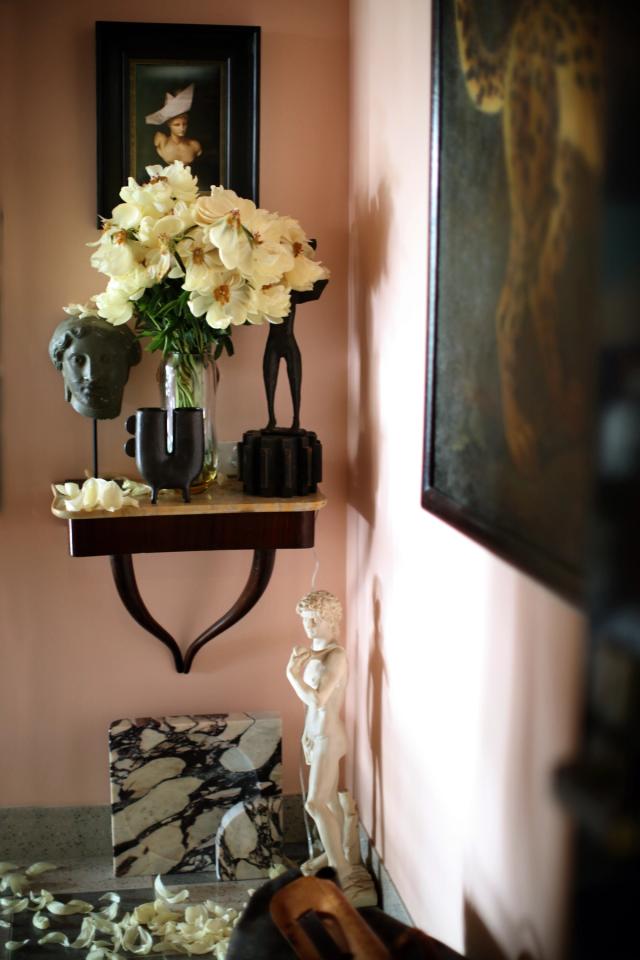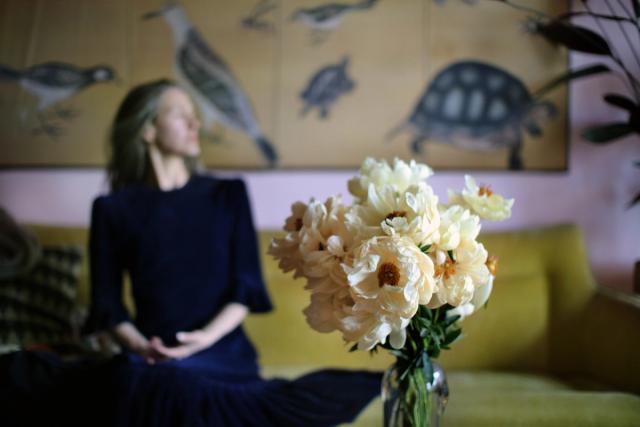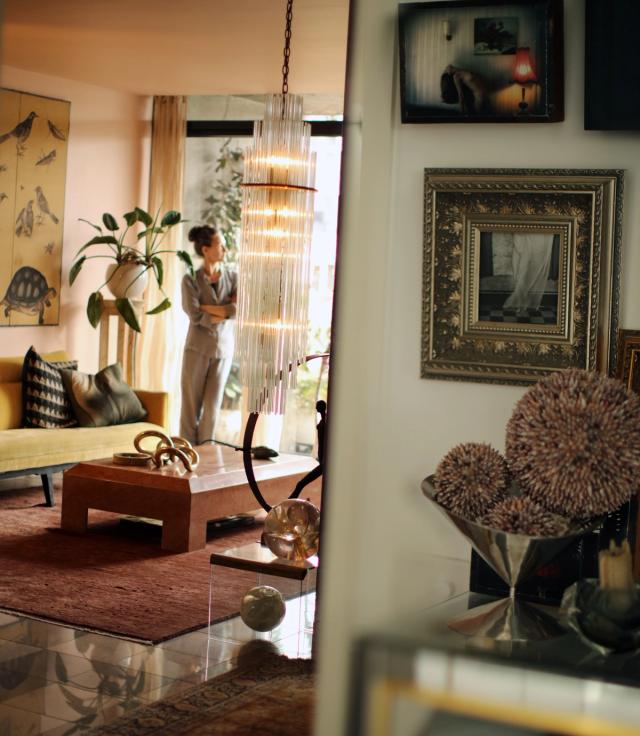

Eryca Judi Green has a frank and fearless appeal. I had known her glancingly through close mutual friends, and we have had amusing chats in the vintage furniture store Opmanis & Green at Smith Street Bazaar in Melbourne’s Fitzroy, which she co-owns with partner Eddy Opmanis. So before the interview I felt I had a handle (albeit a loose one) on what she would be like. But what I experienced was the intense, delightful, distilled version – the parfum not the eau de cologne.
She meets me in the lobby of a large apartment block and we take the lift up to the fourth floor. “These corridors are rather David Lynchian,” she says of the anonymous, artificially lit passages. And indeed their dystopian blandness serves as a foil to the experience of entering her apartment which presents as a garden of earthly delights - a sudden rush of light, colour and a cacophony of things – lots and lots of things – meets the eye. It is an instant dopamine hit and Eryca enjoys the reaction.

“Walking into the apartment is still my favourite moment. The changes in the light never cease to amaze me and I always feel, yes, I'm home,” she says.
To get to this point of joy and appreciation she has gone through some of life’s most challenging struggles, with lock-downs, relationships and a serious health issue marring the last few years.
So for Eryca to have a home to call her own was defining on several levels.


“It’s a space that is only for you and it needs to hug you and look after you and make you feel safe. But then aesthetics kick in and there needs to be an element of theatre, personal pieces that speak to you deeply, and I wanted both. I was not willing to sacrifice one for the other,” she says.
The fact that the apartment is a success is testament to the advice and judgement of good friends. She was lost in a sea of endless looking (and looking…and looking) at places to buy, all which seemed to jump radically in price once under the auctioneer’s hammer. “Eddy found this apartment online, but it was all a bit of a blur for me. I was about to live on my own for the first time in a decade and, although it was prior to the cancer diagnosis I was far from firing on all cylinders, “she recalls.

While it appeared a generic white box there were plus points – it faced north (the desired aspect in Australia), and in a city of constant development, it had a view that would never be built out; it had a generous balcony, it was quiet and it was within budget – just. “So my friend Matthew Lucas was ticking off all the good things and I was just like a zombie at this stage, not realising how unwell I was. And then I'd put an offer in, and somehow, almost by accident, I had bought it.”

Help was at hand. Drawing on the skill set of Julia Cox of interior design practice jcHQ Eryca was able to tap into some really formative decisions. “I wanted concrete flooring, then I wanted terrazzo but Julia talked me into tiling the whole place to give it that Milan apartment feel – and it really works.”

With a reconfigured kitchen designed to hug the southern corner in an L-shape the base of IKEA cabinetry was elevated (literally and figuratively) on elegant brass legs and fitted with a generous marble countertop. Another cunning strategy, ( ‘a stroke of genius by Julia,’ says Eryca ) to pull more light into the apartment, was an enormous floor-to-ceiling curve-edged mirror that bounces light around, and creates a playful dynamism.

Eryca has always been an advocate of economy chic, and has a deeply-embedded egalitarian mindset that is conscious of being even-handed to billionaires and students alike who come into the store. “I have always said, ‘Look if you don't have money, you can do a lot with a tin of paint.’ And so this was my moment to really put my philosophy to the test,” she says. As a long-term proponent of the cocooning power of pink, here she nudges the tone to the peach end of the spectrum. Colour is defining of this space in particular and her oeuvre in general, with manipulation of light and tone, intensity and subtly playing out in her photographic work.

Into this context comes all the richness and variety of object, art, textile and lighting that Eryca’s combination of instinct and intellect tells her strikes the right balance.

“I've come from poverty mentality so I was always squirreling for things in markets and I pride myself that in my home, as in the shop, something can be five dollars or fifty thousand dollars. So the integrity of pieces that make it into my world is what drives me – not what is on trend.”

To this end she has always been ahead of the curve buying Tobia and Afra Scarpa dining chairs before they became design’s hottest ticket.

One of the paradoxes of decorating a small (ish) space is knowing how to play with scale, and when to dial it up— even when it seems counter-intuitive. Her heart was set on an Italian 1950s sideboard by Vittorio Dassi – a cabinetmaker for Gio Ponti before setting up his own business. It was massive and wouldn’t fit in the lift or in the stairwell and so after exploring, and rejecting, a number of other sideboard options the decision was made to cleave it in two, install and mend on-site. “Eddy and friend Frank knew just how important this was to me, and went above and beyond to make it happen,” she says.
Her father always told her to buy the art and objects of friends and that way she would be surrounded by memories, and that has come to pass with a significant wall devoted to a large-scale Stephen Ormandy abstract painting, while a sculptural piece by Jordan Fleming from the Tall Bowls series shifts the dial from vintage to contemporary. There is no ‘set and forget’ here, but instead a space in constant flux – a tweak, a re-arrangement, a new artwork informing a cluster, a chandelier lowered, a piece re-covered.

In her own photographic work, which is often a collaboration with fashion designer/muse Alice Edgeley, there is a poetic quality to the images derived from Eryca’s understanding of how beauty intersects with the off-beat to convey an essential honesty. That is why her portraits are so profound, with subjects as distinguished as the designer/photographer Martyn Thompson declaring her portrayal of him to be one of his very best.
This honesty was super-charged in the self-portrait she produced for a group show at Melbourne’s Oigall Projects. Post-double mastectomy she is shown front-on holding two plastic bags of red drainage fluid from her wounds. It is hard to write but somehow less hard to see, as again there is beauty in the image – the bright yellow of her skirt, the flowers on the table. Her face is not visible – struggling to set up the shot the camera tipped and captured this cropped version which is strangely more powerful without the distraction of face and eye-contact. And this is what I mean by fearless. The objects, the lights, the furniture and art in her world are all hard won and are all the more poignant because of it. Yes there are top-billing designer pieces in the mix, but the aesthetic drivers are life-affirming and joyous – the counterpoint to pain and angst – and who doesn’t want a place ‘that hugs you?’
